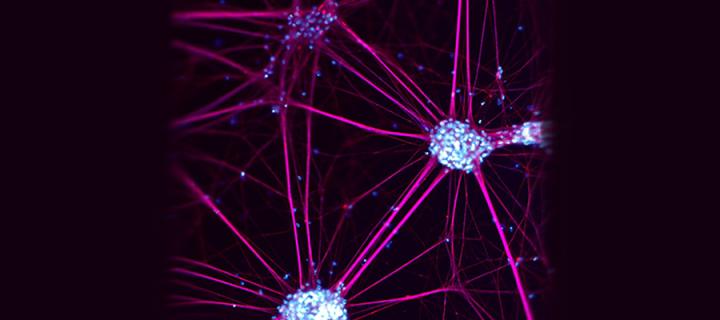Understanding How Nuclear Architecture Affects Neuronal Function in Health and Disease
Supervisors: Prof Nick Gilbert & Dr Marina Chekulaeva

Information in the form of DNA is transcribed into RNA, processed in the nucleus and exported to the cytoplasm where it is translated to make proteins. Individual parts of this pathway are well understood but it is not clear how they function together in normal develop, or why mutations in proteins give rise to developmental phenotypes in specific tissues. Over the last 10-years we have been studying a protein called SAF-A (Scaffold attachment factor A; also called HNRNPU)1. We have shown this is an abundant ubiquitously expressed protein that is important for forming interconnected microgels in the cell nucleus2,3, which provide a unique environment for regulating chromatin (DNA/histone proteins) folding4 and gene expression. Surprising recent data, obtained from deep sequencing individuals with developmental delay, intellectual disability and autism, show that some patients have missense or loss of function mutations in SAF-A5–8.
In this study we will investigate how SAF-A, a protein important for nuclear biology, can give rise to a neurological defect. Our hypothesis is that SAF-A forms a nuclear environment that can facilitate mRNA transport outside the nucleus and target it for translation. We have laid the groundwork for the project by developing a protocol for the efficient generation of motor neurons from hiPSCs. We have also developed a method to isolate neuronal subcellular compartments – cell bodies and axons - for omics analysis, including proteomic, RNA-seq, SLAM-seq, and Ribo-seq (often called spatial omics9–13). Additionally, we developed a technique to map RNA localization elements by integrating a massively parallel reporter assay with the isolation of neuronal compartments, called N-zip9 (neuronal zipcode identification protocol).
Building on this foundation we will apply spatial omics to hiPSC-derived motor neurons depleted of SAF-A or with mutations in individual SAF-A domains. This will enable us to identify proteins and RNAs with varying localization, stability, and translation across the subcellular compartments of SAF-A depleted or mutated neurons, and to identify the regulatory and molecular mechanisms underlying SAF-A related neuronal disease.
References
- Marenda, M., Lazarova, E. & Gilbert, N. The role of SAF-A/hnRNP U in regulating chromatin structure. Curr Opin Genet Dev 72, 38–44 (2022).Marenda, M., Lazarova, E., van de Linde, S., Gilbert, N. &
- Michieletto, D. Parameter-free molecular super-structures quantification in single-molecule localization microscopy. J Cell Biol 220, (2021).
- Nozawa, R.-S. & Gilbert, N. RNA: Nuclear Glue for Folding the Genome. Trends Cell Biol 29, (2019).
- Nozawa, R. S. et al. SAF-A Regulates Interphase Chromosome Structure through Oligomerization with Chromatin-Associated RNAs. Cell 169, 1214-1227.e18 (2017).
- Yates, T. M. et al. De novo mutations in HNRNPU result in a neurodevelopmental syndrome. Am J Med Genet A 173, 3003–3012 (2017).
- Bramswig, N. C. et al. Heterozygous HNRNPU variants cause early onset epilepsy and severe intellectual disability. Hum Genet 136, 821–834 (2017).
- Leduc, M. S. et al. Clinical and molecular characterization of de novo loss of function variants in HNRNPU. Am J Med Genet A 173, 2680–2689 (2017).
- Gillentine, M. A. et al. Rare deleterious mutations of HNRNP genes result in shared neurodevelopmental disorders. Genome Med 13, 63 (2021).
- Mendonsa, S. et al. Massively parallel identification of mRNA localization elements in primary cortical neurons. Nat Neurosci 26, 394–405 (2023).
- Loedige, I. et al. mRNA stability and m6A are major determinants of subcellular mRNA localization in neurons. Mol Cell 83, 2709-2725.e10 (2023).
- Zappulo, A. et al. RNA localization is a key determinant of neurite-enriched proteome. Nat Commun 8, 583 (2017).
- Ciolli Mattioli, C. et al. Alternative 3’ UTRs direct localization of functionally diverse protein isoforms in neuronal compartments. Nucleic Acids Res 47, 2560–2573 (2019).
- Ludwik, K. A., von Kuegelgen, N. & Chekulaeva, M. Genome-wide analysis of RNA and protein localization and local translation in mESC-derived neurons. Methods 162–163, 31–41 (2019).
Marina Chekulaeva Research Group
For informal enquiries about this project, please contact Nick Gilbert (Nick.Gilbert@ed.ac.uk).


